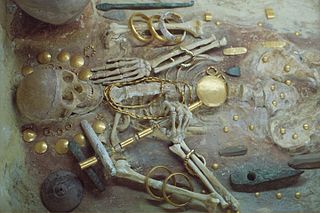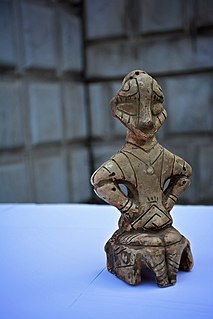
The Neolithic period is the final division of the Stone Age, with a wide-ranging set of developments that appear to have arisen independently in several parts of the world. It is first seen about 12,000 years ago when the first developments of farming appeared in the Epipalaeolithic Near East, and later in other parts of the world. The Neolithic lasted until the transitional period of the Chalcolithic from about 6,500 years ago, marked by the development of metallurgy, leading up to the Bronze Age and Iron Age.

The Vinča culture, also known as Turdaș culture or Turdaș–Vinča culture, was a Neolithic archaeological culture in Southeast Europe, in present-day Serbia, and smaller parts of Bulgaria, Kosovo, North Macedonia, Greece, Bosnia and Romania, dated to the period 5700–4500 BC or 5300–4700/4500 BC. Named for its type site, Vinča-Belo Brdo, a large tell settlement discovered by Serbian archaeologist Miloje Vasić in 1908, it represents the material remains of a prehistoric society mainly distinguished by its settlement pattern and ritual behaviour.

The Starčevo culture is an archaeological culture of Southeastern Europe, dating to the Neolithic period between c. 6200 and 4500 BCE. It originates in the spread of the Neolithic package of peoples and technological innovations including farming and ceramics from Anatolia to the area of Sesklo. The Starčevo culture marks its spread to the inland Balkan peninsula as the Cardial ware culture did along the Adriatic coastline. It forms part of the wider Starčevo–Körös–Criş culture which gave rise to the central European Linear Pottery culture c. 700 years after the initial spread of Neolithic farmers towards the northern Balkans.
Sesklo is a village in Greece that is located near Volos, a city located within the municipality of Aisonia. The municipality is located within the regional unit of Magnesia that is located within the administrative region of Thessaly. During the prehistory of Southeastern Europe, Sesklo was a significant settlement of Neolithic Greece, before the advent of the Bronze Age and millennia before the Mycenaean period.

The Cucuteni–Trypillia culture, also known as the Tripolye culture, is a Neolithic–Eneolithic archaeological culture of Eastern Europe.

The Hamangia culture is a Late Neolithic archaeological culture of Dobruja between the Danube and the Black Sea and Muntenia in the south. It is named after the site of Baia-Hamangia, discovered in 1952 along Golovița Lake.

Skenderaj or Srbica is a town and municipality located in the Mitrovica District of Kosovo. According to the 2011 census, the town of Skënderaj has 9,372 inhabitants, while the municipality has 50,858 inhabitants.

The Varna culture is a later Neolithic European culture of northeastern Bulgaria, dated ca. 4500 BC, contemporary and closely related with Gumelnița in southern Romania, often considered as local variants.
Vinča-Belo Brdo is an archaeological site in Vinča, a suburb of Belgrade, Serbia. The tell of Belo Brdo is almost entirely made up of the remains of human settlement, and was occupied several times from the Early Neolithic through to the Middle Ages. The most substantial archaeological deposits are from the Neolithic-Eneolithic Vinča culture, of which Vinča-Belo Brdo is the type site.
Štulac is a village in the municipality of Lebane, Serbia. According to the 2011 census, the village had a population of 279. On the territory of the small village there are two archaeological sites. One is the Archaeological sites of exceptional importance Iustiniana Prima, a 6th-century Byzantine city built by the emperor Justinian I, and the other is Svinjarička Čuka locality, a Neolithic settlement, discovered in 2017–2018.

Romanian art consists of the visual and plastic arts originating from the geographical area of Romania. The production of art in Romania is as old as the Paleolithic, an example being a cave painting from the Cuciulat Cave. During the Neolithic, multiple cultures lived on the modern territory of Romania. Their material culture included pottery and abstract clay statuettes decorated with geometric patterns. These may give hints on the way these civilizations used to dress and maybe tattoo. A good examples of this is the Thinker of Hamangia, a clay figurine produced by the Hamangia culture. Important cultures of the Neolithic era include Starčevo–Körös–Criș, Boian, Gumelnița–Karanovo, and other ones, the most famous and at the same time the most evolved among them in art being the Cucuteni–Trypillia culture. During Antiquity, the Geto-Dacians produced art and built multiple cities of the dava type. Greek colonies appear in Dobruja, including Tomis, and Mangalia. After the Dacian Wars, Emperor Trajan transformed a big part of Dacia into a province of the Roman Empire. The province underwent an intense process of Romanization.

Goddess on the Throne is a terracotta figurine found at the site of the Tjerrtorja spinning mill in Pristina, the capital city of Kosovo, in 1956. The seated terracotta figure is a well-preserved specimen of small Neolithic plastic Vinča culture. It measures 18.5 cm high and is dated to 5700–4500 BC.

Archaeology of Kosovo as a field of study and research was started in the second half of the 20th century. Kosovo's field of archaeology has developed in tandem with the historical study, studies of ancient authors' sources, classic philological studies, theological data research, topographic studies and ground survey, analysis of toponyms, deciphering of epigraphic and historiographic data. First data about antique monuments in Kosovo, were documented from the end of the 19th until the beginning of the Second World War, a time period when Kosovo was visited by researchers, guides, and archaeologists such as: Evans, Boue, Hahn, Kanitz, Tomaschek, Domaschevski, Arpad, Vulic, Jirecek, Patsch, Domenico Mustilli, etc. In the 1950s, a new era for the ancient studies of Kosovo begins, with prehistoric and antiquity research. Proper development of scientific archaeological research methods starts with the founding of the Museum of Kosovo in 1949, and later these studies are made helped with the establishment of other relevant local and regional institutions. In 2003, Ministry of Culture, Youth and Sports of Kosovo establishes the Archaeological Institute of Kosovo, and since then, continually, besides informative campaigns in field, many archaeological sites were excavated and recorded. Since then geophysical, geomagnetic archaeometallurgical and archaeobotanic studies were performed at some archaeological sites in close cooperation with partners from Germany such as the German Archaeological Institute, and other relevant international institutions with the same inter-disciplinary access. The municipality of Ferizaj specifically has been rich in archaeological findings.

Late Antiquity in Kosovo brings different currents of change that reverberate and affect it as well as the whole extent of the Roman Empire. It starts at the time of Constantine the Great, who was born in ancient Dardania with the acceptance and spread of Christianity, and continues as a tumultuous period because of the different barbaric invasions that plague the empire at that time, be that by Goths, Avars, Slavs, etc. Kosovo was always in an interesting strategic position, being situated between the old-world East and West, at that time the eastern and western Roman empire. With the decline of the western Roman Empire, we see an intriguing development where some of the emperors of Rome are Illyrians or Dardanians. To list a few prominent ones: Justinian, Constantine, and Diocletian. They bring a breath of fresh air to the antiquated system of government of Rome and replace the capital to Constantinople, which brings forth a new surge of civilization and knowledge. While the Dark Age is in full swing in Europe, Kosovo and Balkans in general see a migration of new people in its territories, and even though not in peace, see a period of progression. The old knowledge of the Classics is not lost nor forgotten, and a new development in art and architecture starts. This puts Kosovo in an interesting position being that it becomes a bridge through which we see these different influences of civilization happen, whereas we see an influence of Romanesque, Byzantine, and later Ottoman styles of life, philosophy, religion and architecture. We also see during this tumultuous period the building of many fortifications to protect the population from the uncertainties of conquest from abroad.
The metal period incorporates a long stretched timeline of over three millennia, commencing from approximately 3500 BC up to middle of the 4th century BC. During this time, which includes the Copper, Bronze, and Iron Age periods we see the sophistication of life among the inhabitants of ancient Kosovo. This periods are well substantiated with archaeological findings, ranging from settlements to necropolises of different types, predominately tumuli. There are vast amounts of artifacts that have been collected and uncovered during the last century from these settlements and tombs, which prove the existence of civilization, and its continuation from prehistoric periods.

Part of a series of articles upon Archaeology of Kosovo
Vlashnjë is a village in the Prizren municipality of Kosovo. It has 1,700 inhabitants as of 2011. Vlashnjë is a multi-layered settlement and site area. Archaeological excavations have identified habitation and use of the area since the Neolithic era. The rock art paintings at Mrrizi i Kobajës are the first find of prehistoric rock art in Kosovo. In late antiquity, Vlashnja was a fortified settlement part of the fortification network which Justinian I rebuilt along the White Drin in Dardania.
The strategic position of the region of Mitrovica in the middle of two great rivers Ibar and Sitnica and its mineral wealth in Albanik, made this location populated since prehistoric period. This region was populated by Illyrians, respectively members of the Dardan tribe. The first data for the archaeological sites in the region of Mitrovica, begin with the researches of Sir Artur John Evans, who was the first to pinpoint the Roman town of the Municipium Dardanourm. In the archaeological sites of the region of Mitrovica were found traces and objects from different periods such as; Neolithic, Roman, late antiquity and medieval period. Objects and figurines include: fortress vestiges, necropolis, Terpsichore figure, statues, sarcophagus, altar, jewelry, etc.
Crkvine is a Neolithic locality and an archaeological site in the village of Stubline in the municipality of Obrenovac, which is part of the City of Belgrade, the capital of Serbia. The Neolithic settlement is dated to the 5th millennium BC and was part of the Vinča culture. The research of the site began in 1962 and the locality was declared a cultural monument in 2014.
Runik is a village in the Skenderaj municipality of Kosovo. It is located in the Drenica region and has 1,585 inhabitants as of 2011. The village has a football club, KF Përparimi Runik. Runik is the site of an important Neolithic settlement in Kosovo and the wider region. The excavated finds at the site include a baked-clay ocarina, one of the oldest musical instruments which have been in the Balkans and the oldest in Kosovo.













